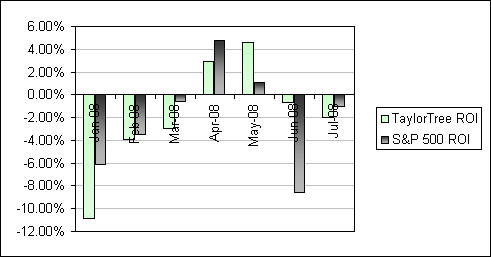I would like to have done a better job at my first portfolio performance post. But, I'm afraid I've been extremely busy at my day job. So, please be patient. My hope for future performance posts is to include much more information about the returns and portfolio breakdown.

One of the difficult items I've found in preparing for posting of portfolio performance is the lack of good tools. I've tried quite a few products the past few months and was about to give up hope until I found
Icarra. Sweet product. One of the hardest things to create is a simple product. So many developers miss the mark...the tendency is to focus on the bells and whistles.
Icarra hits the mark with it's great charts, sector breakdowns, and ease of trade entry.
This is a good segway into developing a portfolio. As an investor, you have unlimited choices. Question to ask yourself...do you focus on the bells and whistles? Or do you hunker down and keep your choices simple...your strategy simple. If you find yourself changing your portfolio on every market downturn just because you feel like you should be doing something...then maybe it's time to refocus. Are you really improving your portfolio returns? Or just keeping yourself busy?
Now, back to portfolio performance. There are some things to note. I have not entered my actual entry prices into Icarra. Just too much data to sift thru in order to accomplish that. Instead, I have entered all the positions as if I bought them on the last day of 2007 (12/31/2007). From this point forward I will enter all sells, new buys, dividends, interest, etc. into Icarra. But, keep in mind...all performance is based on the clean slate of 2008.
Below is the breakdown of sectors in the portfolio. This is one area that I found some differences in the chart and the actual breakdown in Icarra. But, useful nonetheless. I'll contact Icarra to find the reason for the difference and post in the next performance release.

You can see, I now have a very large cash position in the portfolio. I don't like this, I have to admit. This will cause the portfolio to lag should the market gain back momentum. But, this is the normal process of the system. During market downturns like we've had...the trailing stops are hit and the bugs in the portfolio are killed. Then we have the waiting game for new signals. The goal, of course, is to be 100% invested in the market...that is what generates our returns. But, all seasons have their winters...and this is where we bundle up and wait for the ice to melt.
Another area I want to point out in the sector breakdown is the lack of consistency in the sector weightings. My goal is to have a better balance in the sector weightings. These sector weightings cannot always be controlled due to the nature of the system's signals. Some sectors may be very cold and other sectors can be very hot. Based on the weightings above, the services sector was pretty hot for 2007....and have held up relatively well in the portfolio during our bug killing in the recent market downturn.
Finally, I want to review the monthly returns of the portfolio...

Pretty large differential between the portfolio's monthly returns and the S&P 500's. The system is more volatile than the market and as result drawdowns and gains are larger. This is par for the course with trend following systems in general. It takes a lot of patience to trade a trend following system. Especially, a long-term trend following system. But, I truly believe, that's where the returns are in the long-term.
Can this be improved? Possibly. There are ideas I have yet to test that could trim the portfolio's volatility. And hopefully, I'll get a chance to test these ideas in the months to come.
If you have any questions or would like to see other aspects of the portfolio...drop me a line.
Later trades,
MT
This post is for information and entertainment purposes only. Under no circumstances does this information represent a recommendation to buy or sell securities or any other type of investment instruments.









